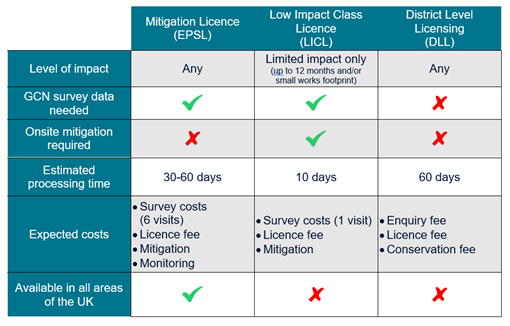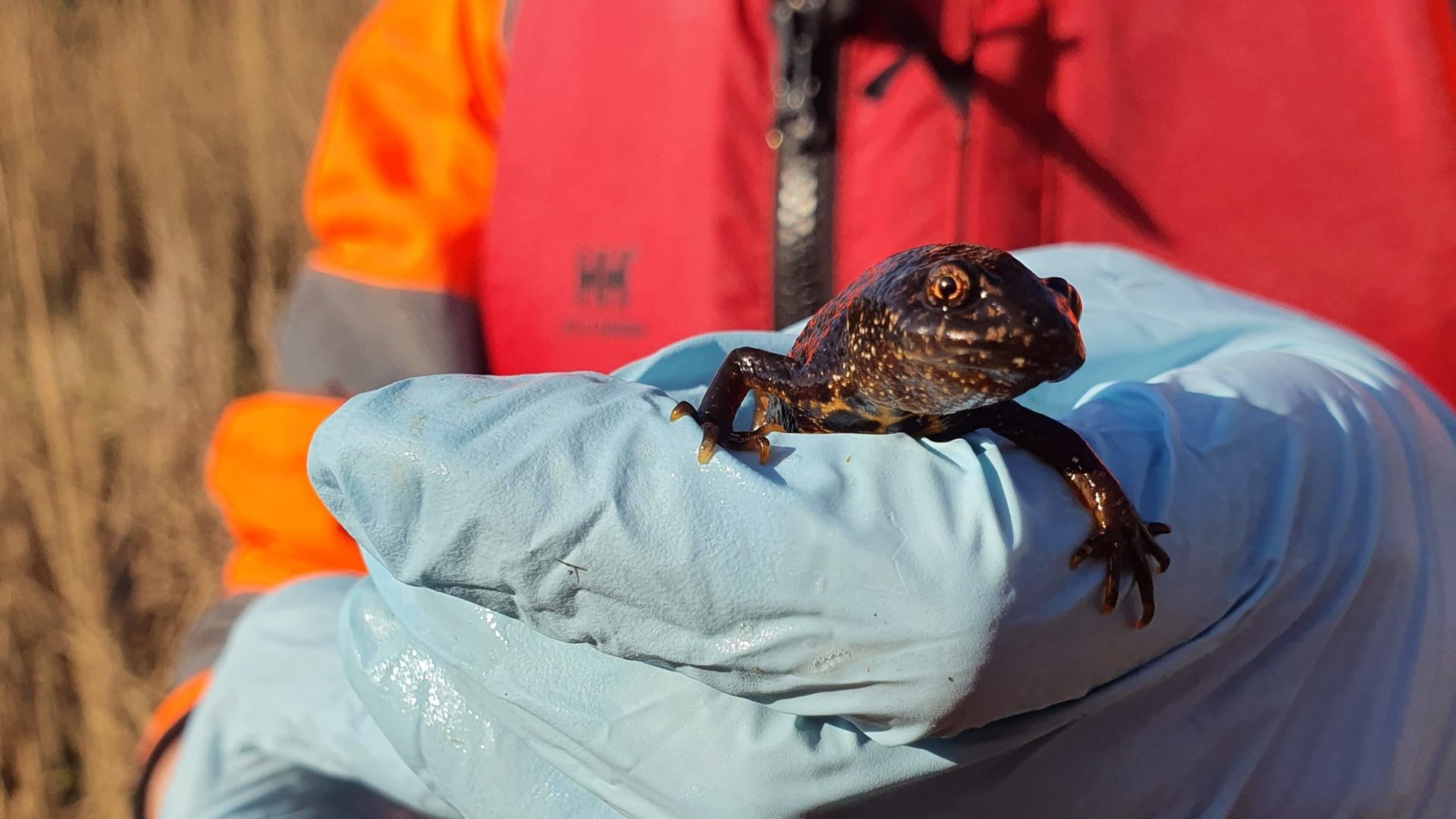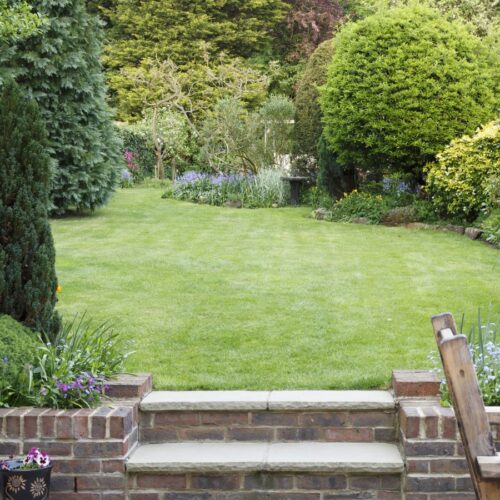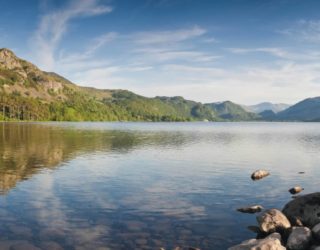We are now a month into the great crested newt survey season, but it won’t be long until the season wraps up at the end of June. That’s why deciding whether your upcoming project will likely require a licence, knowing what licence options are available to you and whether great crested newt surveys are required, is essential for project planning to ensure there are no unexpected delays and costs.
Great crested newts – still fully protected post-Brexit!
The UK is home to three species of newt: the smooth newt, the palmate newt and the great crested newt (GCN). Due to the decline of GCN across Europe, they are a protected species by both European and UK legislation. This makes it illegal to:
- Capture, kill, disturb or injure a GCN
- Damage or destroy a resting or breeding place
- Obstruct access to their resting or sheltering places
- Possess, sell, control or transport live or dead newts, or parts of them
- Take great crested newt eggs.
If anyone is found guilty of any of the above, this could result in an unlimited fine and up to 6 months in prison for each offence. In the first instance, any planned activity likely to impact GCN or their habitats, should be avoided. If this is not possible, a licence will be required to undertake the work lawfully.
Step 1 – Could great crested newts be using the site?
GCN are not only found in ponds. In fact, they spend much of their lifetime on land, only returning to ponds and other waterbodies to breed in the spring. As GCN can travel as far as 500m from their breeding ponds, they may be found in suitable terrestrial habitats on proposed development sites even if there are no ponds or waterbodies within the site boundary. They are widely distributed across lowland Great Britain and the total UK population is relatively large, distributed across sites of varying ecological character. Thomson ecologists have often found GCN in some very unexpected places including railway ballast, drainage systems and waste land.
Great crested newts should be considered in project planning if:
- There are records of GCN within 1km of the site
- There is a suitable standing waterbody (ponds and ditches) within 500m of the site; and
- There is suitable aquatic breeding habitat or terrestrial resting habitat on the site.
Step 2 – Will great crested newts be impacted by the works?
The second question to ask is… if GCN or their habitat is on or near the site then will the proposed activity have negative impacts on them?
Activities that can affect GCN and their habitats include, but are not limited to: vegetation clearance, ground excavations, maintenance works to any habitat suitable for GCN, filling in ponds, changing land use and management and removing materials like dead wood piles.
If you are in any doubt whether GCN could be affected on your site, contact your local Thomson team who will be happy to advise. We regularly undertake Preliminary Ecological Appraisals (PEAs) which is an initial assessment of a site to determine its likelihood of supporting protected species.
Step 3 – Which licence do I need?
Any unavoidable activity likely to impact GCN or their habitats will need a licence for the work to be undertaken lawfully. The licence enables derogation from protection normally afforded to the species and can only be issued for projects with a purpose of preserving public health or safety, or projects of imperative reason of overriding public interest. Furthermore, the licensing authority must be satisfied that there is no satisfactory alternative and that the action authorised will not be detrimental to the maintenance of the species concerned at a favourable conservation status in their natural range.
There are three licence options available for GCN work. A professional ecologist will be able to advise on the most suitable licence type based on the project specifics including its location, the duration of the proposed works, the size of the site and the number of waterbodies that will be affected (or distance to the nearest waterbody).

The traditional route – Natural England Mitigation Licence – EPSL
The traditional licence (also known as a Mitigation Licence or European Protected Species Licence (EPSL)) is appropriate for works of any size and duration, so long as mitigation is in place to conserve the favourable conservation status of GCN. Measures are likely to be needed to reduce the likelihood of killing or injuring newts and compensation for lost or damaged habitats is likely required.
To apply for an EPSL, you will need detailed data showing the GCN population size. This usually requires up to six survey visits by ecologists which can only be undertaken between mid-March and mid-June. A suitably experienced ecologist must complete the licence application on behalf of the developer, detailing the potential impact to GCN and a proportionate mitigation strategy.
The low impact route – Natural England Low Impact Class Licence (LICL) – CL33
LICL is a suitable alternative to the full EPSL where the impacts to GCN are below a threshold detailed by Natural England. These can include:
- Damage or destruction to terrestrial habitats,
- Temporary damage or destruction to ditches,
- Temporary disturbance (e.g. temporarily excluding GCN from an area), and
- Activities requiring capture of GCN and movement to a safe place.
These licenses are only available in England and are typically for projects of less than 12 months. They are designed for limited impacts on terrestrial habitats with the area that can be licensed increasing the further the project is from the GCN pond. For example, within 50m of a pond, the LICL only allows 0.05ha of terrestrial habitat to be temporarily damaged, however beyond 100m of the pond the licence can cover 5ha.
Because of the lower impacts to GCN, the supporting data only normally needs to confirm the presence of GCN (rather than a population size estimate) – this is most easily achieved by taking a water sample which can be analysed for the presence of environmental DNA (eDNA). Thomson environmental consultants works closely with a partner eDNA laboratory that has undertaken Natural England proficiency testing.
Once the site is registered under LICL, measures must be taken before/during the works to implement the agreed mitigation. This might include fencing and trapping to exclude GCN from the work area and/or an ecologist during all site works to search for and relocate any GCN from the impact zone.
Thomson environmental consultants have Natural England Registered Consultants that are able to register sites under the GCN Low Impact Class Licence System and can advise clients that require this licensing option.
The district level route – District Level Licence (DLL)
The DLL is a relatively new GCN licence option which can be granted at any time of year and is now available in most areas of England. The DLL differs from the traditional route in that any impacts to GCN are offset at a district or county-level rather than site-level and uses a conservation fee from developers that is used to create and maintain new ponds and habitat in locations that will benefit the species for the foreseeable future.
District Level Licences are often cheaper than traditional EPSL and reduce the risk of project delays as GCN surveys, fencing and trapping on site is usually not required. However, there is a risk that GCN within the development could be harmed by the works. To mitigate this, an ecologist acting as an Ecological Clerk of Works can be present during any vegetation clearance to fingertip search and relocate any newts to a place of safety.
Thomson environmental consultants have a 100% success rate in applications for each of these licence types and would be more than happy to help on your next project
Tel: 01483 466 000
Email: [email protected]











